System Design and Energy Management for a Fuel Cell/Battery Hybrid Forklift
Abstract
:1. Introduction
2. Topology of the Fuel Cell/Battery Hybrid Power System
3. Fuel Cell/Battery Hybrid Power System Design
3.1. Hybrid Power System Description
3.2. Air-Cooled PEMFC System
3.3. PEMFC Controller Design
3.4. Unidirectional Buck-Boost DC/DC Converter Design
3.5. Battery Energy Storage System
3.6. Energy Management Controller Design
3.7. Hybrid Forklift System
4. Energy Management Strategy Based on Load Current Following
4.1. Analysis of Characteristics of Hybrid Energy
4.2. Energy Management Strategy Based on Load Current Following
- (1)
- To enable the DC Bus voltage to stay the allowable voltage range of the forklift motor.
- (2)
- To prevent battery overcharge and over discharge, to keep the SOC of battery at a reasonable level, and to reserve enough energy for next start-up of the system.
- (3)
- To keep the fuel cell working at the optimal working point in varying environments, the fuel cell output power optimal, and the fuel utilization efficiency the highest.
- (4)
- To keep the output current and power of the fuel cell steady, prevent the output from changing with the load power, and to follow the change of load power gradually until the maximum power output is reached.
- (1)
- When IBattery > 0, this indicates that the ILoad is greater than the IDC/DC.out, and the battery is in the discharged state. The energy management control strategy immediately determines whether the IDC/DC.set is the IDC/DC.max If IDC/DC.set is equal to IDC/DC.max, keep the IDC/DC.set unchanged, and the output power of the fuel cell remains unchanged. If IDC/DC.set is less than IDC/DC.set, the |TFC.err| needs to be detected. If |TFC.err| is greater than ξ, it indicates that the fuel cell has not yet reached the optimal output from the previous output state to the current output state, and the stack activation is insufficient (increasing the output current when the stack activation polarization is insufficient, may enable the voltage of the single cell to be reduced to less than 0.5 V, causing the stack to reverse-polarize and damage the stack), the output current of the fuel cell is kept unchanged. If |TFC.err| is less than ξ, it indicates that the stack is fully activated, and the output current of the fuel cell can be increased by ∆IFC.add. Then the energy management control strategy modifies the IDC/DC.set to increase the fuel cell output current ∆IFC.add (when the adjusted value exceeds the maximum output value of the fuel cell, the IDC/DC.set is equal to the maximum output value of the fuel cell). This adjustment is repeated to enable the output current of the fuel cell to follow the request current of the forklift motor gradually, until the output current of the fuel cell reaches a maximum value.
- (2)
- When IBattery < 0, this indicates that the ILoad is less than the IDC/DC.out, and the battery is in the charging state. The energy management control strategy immediately determines whether the IDC/DC.set is the IDC/DC.min. If IDC/DC.set is equal to IDC/DC.min, keep the IDC/DC.set unchanged, and the output power of the fuel cell remains unchanged. In order to prevent the sudden increase of ILoad causing the output current of the fuel cell to immediately increase to the IDC/DC.set, and the single cell voltage of the fuel cell is too low or a large peak current occurs affects the normal operation of the PEMFC controller, it is necessary to judge whether the difference between the IDC/DC.set and ILoad is greater than the reduction adjustment threshold ∆IFC.dec, if IDC/DC.set is greater than IDC/DC.min. If the difference is greater than the adjustment threshold ∆IFC.dec, the energy management controller recalculates the SOC of battery, and selects an appropriate charging current IBattery according to the current SOC of battery, and takes the sum of IBattery and ILoad as the new setting value of IDC/DC.set. With the increase of the SOC, the charging current of the battery will gradually decrease.
4.3. Test of Energy Management Strategy
5. Test and Result of Hybrid Forklift
6. Conclusions
Author Contributions
Funding
Conflicts of Interest
References
- Jensen, H.B.; Schaltz, E.; Koustrup, P.S.; Andreasen, S.J.; Kaer, S.K. Evaluation of fuel-cell range extender impact on hybrid electrical vehicle performance. IEEE Trans. Veh. Technol. 2013, 62, 50–60. [Google Scholar] [CrossRef]
- Lachhab, I.; Krichen, L. An improved energy management strategy for FC/UC hybrid electric vehicles propelled by motor-wheels. Int. J. Hydrog. Energy 2014, 39, 571–581. [Google Scholar] [CrossRef]
- Lototskyy, M.V.; Tolj, I.; Parsons, A.; Smith, F.; Sita, C.; Linkov, V. Performance of electric forklift with low-temperature polymer exchange membrane fuel cell power module and metal hydride hydrogen storage extension tank. J. Power Sour. 2016, 316, 239–250. [Google Scholar] [CrossRef]
- Garche, J.; Jörissen, L. Applications of fuel cell technology: Status and perspectives. Electrochem. Soc. Interface 2015, 24, 39–43. [Google Scholar] [CrossRef]
- Sharaf, O.Z.; Orhan, M.F. An overview of fuel cell technology: Fundamentals and applications. Renew. Sustain. Energy Rev. 2014, 32, 810–853. [Google Scholar] [CrossRef]
- Das, V.; Padmanaban, S.; Venkitusamy, K.; Selvamuthukumaran, R.; Blaabjerg, F.; Siano, P. Recent advances and challenges of fuel cell based power system architectures and control–A review. Renew. Sustain. Energy Rev. 2017, 73, 10–18. [Google Scholar] [CrossRef]
- Kunusch, C.; Puleston, P.; Mayosky, M. PEM Fuel Cell Systems. In Sliding-Mode Control of PEM Fuel Cells. Advances in Industrial Control; Springer: London, UK, 2012. [Google Scholar]
- Comparison of Fuel Cell Technologies. U.S. Department of Energy, Energy Efficiency and Fuel Cell Technologies Program. February 2011. Available online: https://www1.eere.energy.gov/hydrogenandfuelcells/fuelcells/pdfs/fc_comparison_chart.pdf (accessed on 4 August 2011).
- Hsieh, C.-Y.; Nguyen, X.-V.; Weng, F.-B.; Kuo, T.-W.; Lee, C.-Y.; Su, A. Developing Hybrid–Power Fuel Cells with a Low–Pressure Hydrogen–Storage System used in an Electric Forklifts. Int. J. Electrochem. Sci. 2017, 12, 6266–6281. [Google Scholar] [CrossRef]
- Keränen, T.M.; Karimäki, H.; Viitakangas, J.; Vallet, J.; Ihonen, J.; Hyötylä, P.; Uusalo, H.; Tingelöf, T. Development of integrated fuel cell hybrid power source for electric forklift. J. Power Sour. 2011, 196, 9058–9068. [Google Scholar] [CrossRef]
- Houf, W.G.; Evans, G.H.; Ekoto, I.W.; Merilo, E.G.; Groethe, M.A. Hydrogen fuel-cell forklift vehicle releases in enclosed spaces. Int. J. Hydrog. Energy 2013, 38, 8179–8189. [Google Scholar] [CrossRef]
- Lototskyy, M.V.; Tolj, I.; Davids, M.W.; Klochko, Y.V.; Parsons, A.; Swanepoel, D.; Ehlers, R.; Louw, G.; van der Westhuizen, B.; Smith, F. Metal hydride hydrogen storage and supply systems for electric forklift with low-temperature proton exchange membrane fuel cell power module. Int. J. Hydrog. Energy 2016, 41, 13831–13842. [Google Scholar] [CrossRef]
- Sabri, M.F.M.; Danapalasingam, K.A.; Rahmat, M.F. A review on hybrid electric vehicles architecture and energy management strategies. Renew. Sustain. Energy Rev. 2016, 53, 1433–1442. [Google Scholar] [CrossRef]
- Sulaiman, N.; Hannan, M.A.; Mohamed, A.; Majlan, E.H.; Daud, W.W. A review on energy management system for fuel cell hybrid electric vehicle: Issues and challenges. Renew. Sustain. Energy Rev. 2015, 52, 802–814. [Google Scholar] [CrossRef]
- Wu, B.; Parkes, M.A.; Yufit, V.; De Benedetti, L.; Veismann, S.; Wirsching, C.; Vesper, F.; Martinez-Botas, R.F.; Marquis, A.J.; Offer, G.J. Design and testing of a 9.5 kWe proton exchange membrane fuel cell–supercapacitor passive hybrid system. Int. J. Hydrog. Energy 2014, 39, 7885–7896. [Google Scholar] [CrossRef]
- Shin, M.-H.; Eom, T.-H.; Park, Y.-H.; Won, C.-Y. Design and control of fuel cell-battery hybrid system for forklift. In Proceedings of the 2016 IEEE Conference and Expo Transportation Electrification Asia-Pacific (ITEC Asia-Pacific), Busan, Korea, 1–4 June 2016; pp. 584–589. [Google Scholar]
- Han, Y.; Chen, W.; Li, Q. Energy management strategy based on multiple operating states for a photovoltaic/fuel cell/energy storage DC microgrid. Energies 2017, 10, 136. [Google Scholar] [CrossRef]
- Hong, Z.; Li, Q.; Han, Y.; Shang, W.; Zhu, Y.; Chen, W. An energy management strategy based on dynamic power factor for fuel cell/battery hybrid locomotive. Int. J. Hydrog. Energy 2018, 43, 3261–3272. [Google Scholar] [CrossRef]
- Jia, J.; Li, Q.; Wang, Y.; Cham, Y.T.; Han, M. Modeling and dynamic characteristic simulation of a proton exchange membrane fuel cell. IEEE Trans. Energy Convers. 2009, 24, 283–291. [Google Scholar] [CrossRef]
- Li, Q.; Chen, W.; Liu, S.; Gao, Z.; Yang, S. Temperature optimization and control of optimal performance for a 300 W open cathode proton exchange membrane fuel cell. Procedia Eng. 2012, 29, 179–183. [Google Scholar] [CrossRef]
- Wei, D.; Zheng, D.; Chu, L. Output control of optimal performance for air-cooling PEMFC stack. CIESC J. 2010, 5, 1293–1300. [Google Scholar]
- You, Z.; Xu, T.; Liu, Z.; Peng, Y.; Cheng, W. Study on air-cooled self-humidifying PEMFC control method based on segmented predict negative feedback control. Electrochim. Acta 2014, 132, 389–396. [Google Scholar]
- Zhi, Y.; Tao, L.; Qing, S.; Qi, L. Design of Generation Controller of Air-Cooled Self-Humidifying Proton Exchange Membrane Fuel Cell. Trans. China Electrotech. Soc. 2018, 33, 442–450. [Google Scholar]
- Xu, L.; Ouyang, M.; Li, J.; Yang, F.; Lu, L.; Hua, J. Application of Pontryagin’s Minimal Principle to the energy management strategy of plugin fuel cell electric vehicles. Int. J. Hydrog. Energy 2013, 38, 10104–10115. [Google Scholar] [CrossRef]
- Carignano, M.G.; Costa-Castelló, R.; Roda, V.; Nigro, N.M.; Junco, S.; Feroldi, D. Energy management strategy for fuel cell-supercapacitor hybrid vehicles based on prediction of energy demand. J. Power Sour. 2017, 360, 419–433. [Google Scholar] [CrossRef]
- Ahmadi, S.; Bathaee, S.M.T.; Hosseinpour, A.H. Improving fuel economy and performance of a fuel-cell hybrid electric vehicle (fuel-cell, battery, and ultra-capacitor) using optimized energy management strategy. Energy Convers. Manag. 2018, 160, 74–84. [Google Scholar] [CrossRef]
- Zhang, W.; Li, J.; Xu, L.; Ouyang, M. Optimization for a fuel cell/battery/capacity tram with equivalent consumption minimization strategy. Energy Convers. Manag. 2017, 134, 59–69. [Google Scholar] [CrossRef]
- Ettihir, K.; Boulon, L.; Agbossou, K. Optimization-based energy management strategy for a fuel cell/battery hybrid power system. Appl. Energy 2016, 163, 142–153. [Google Scholar] [CrossRef]
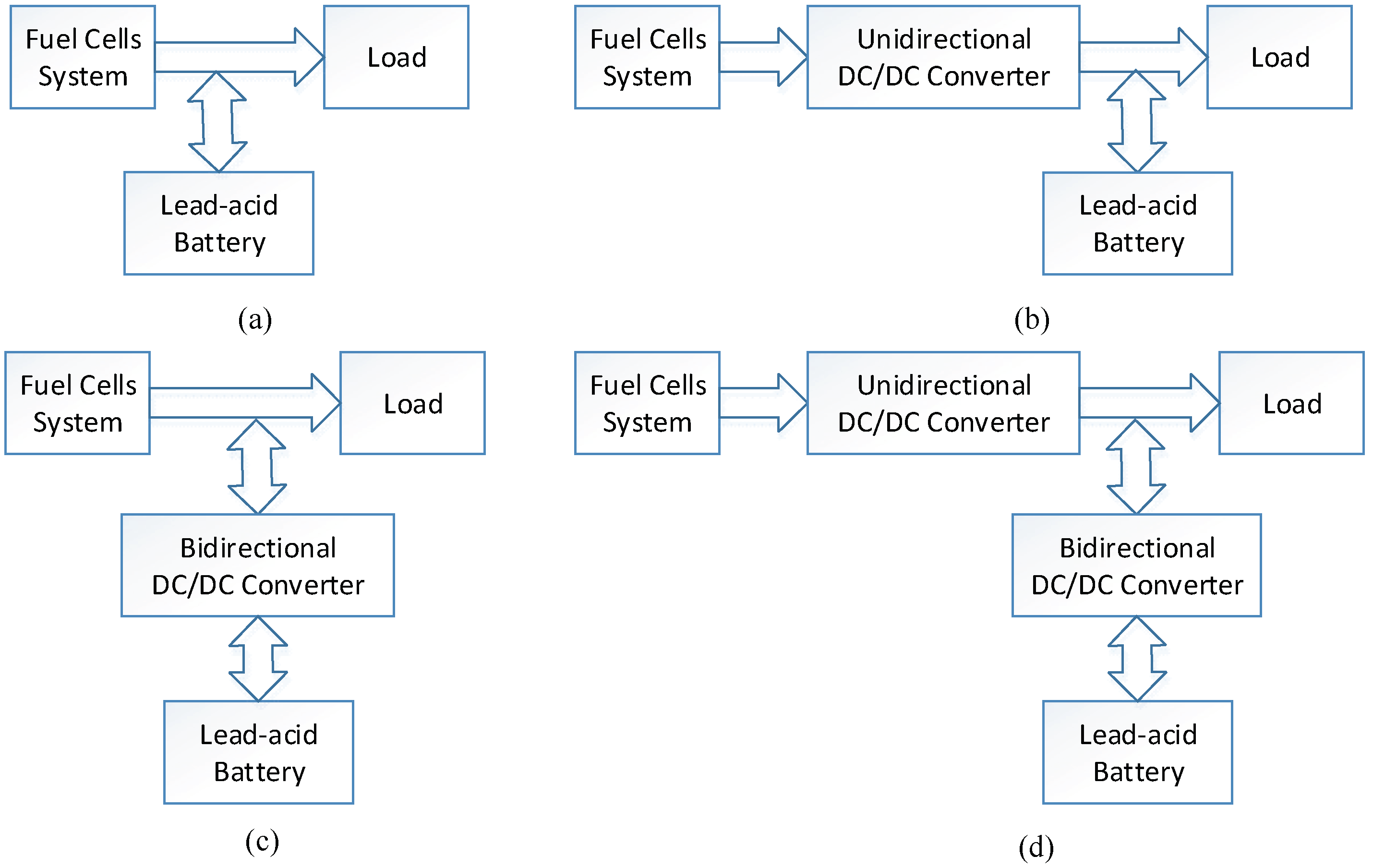
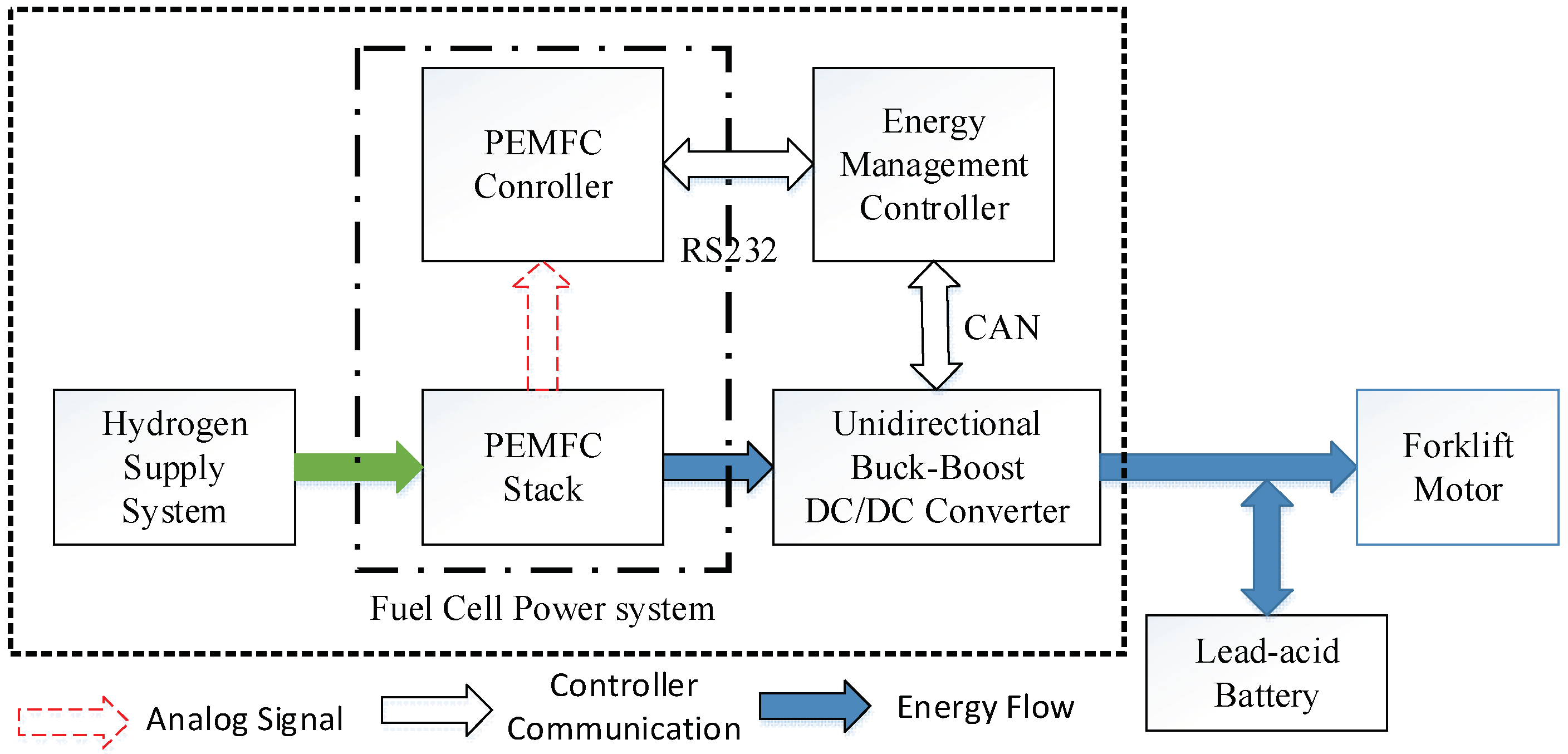
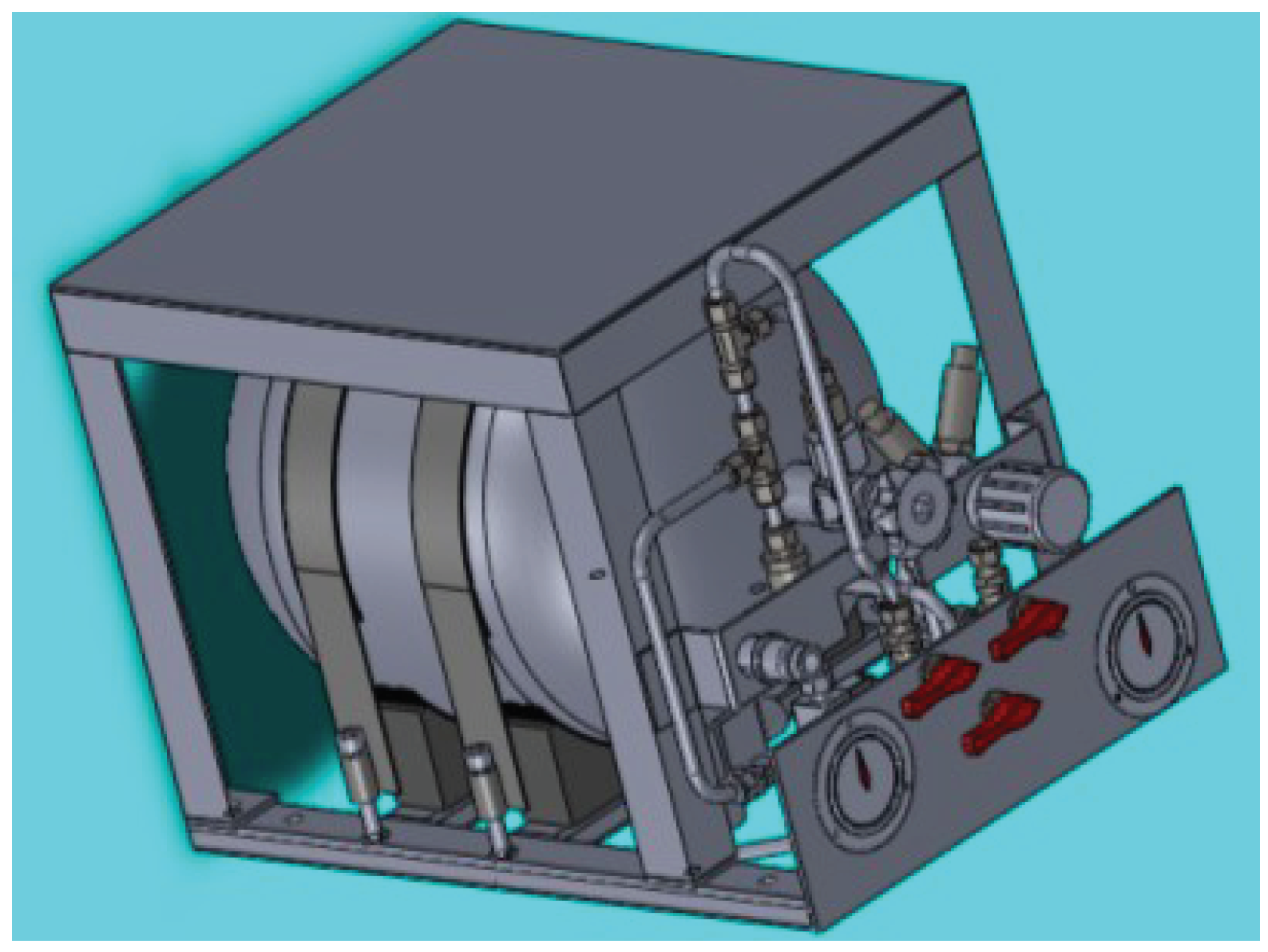
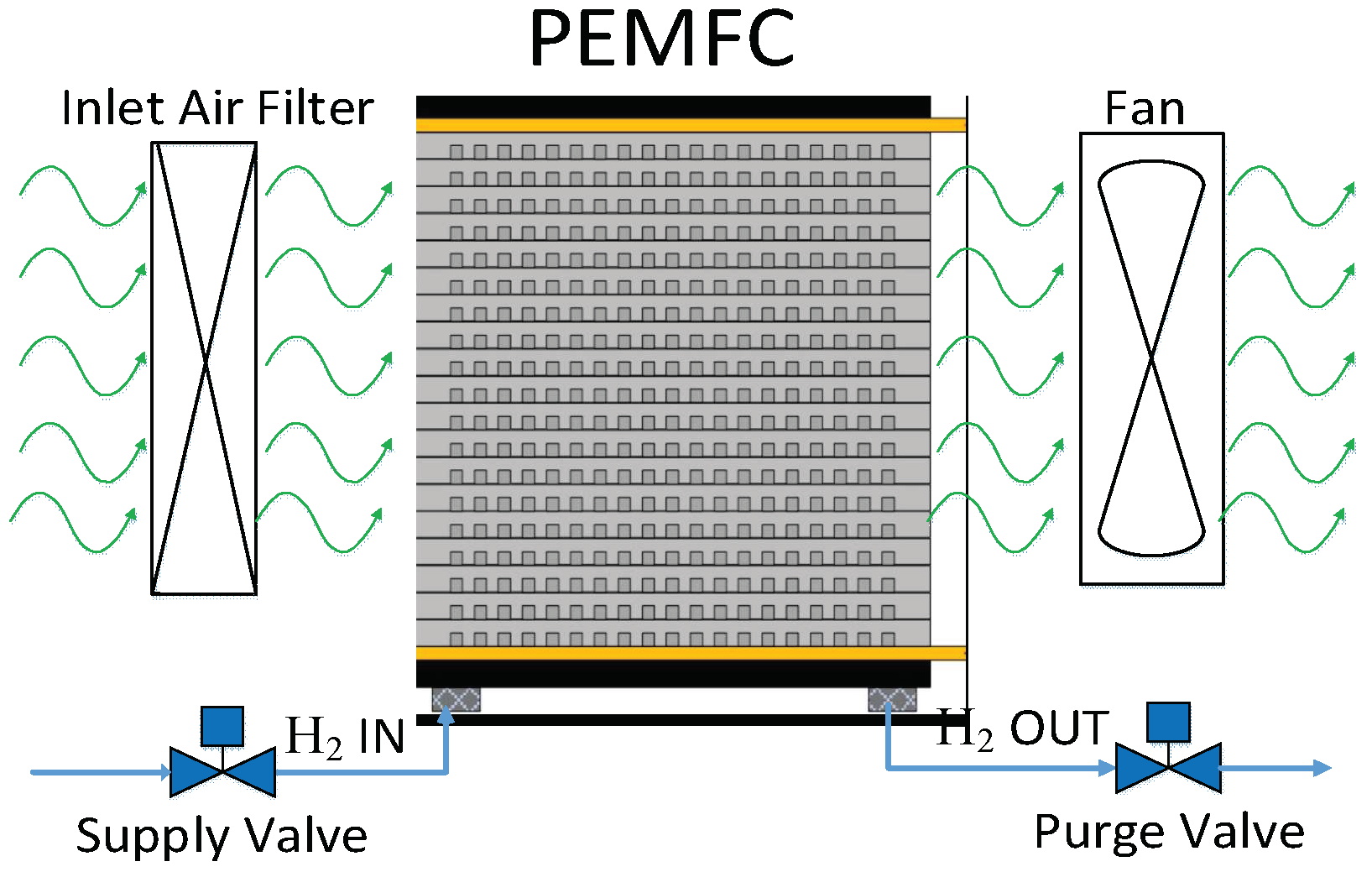
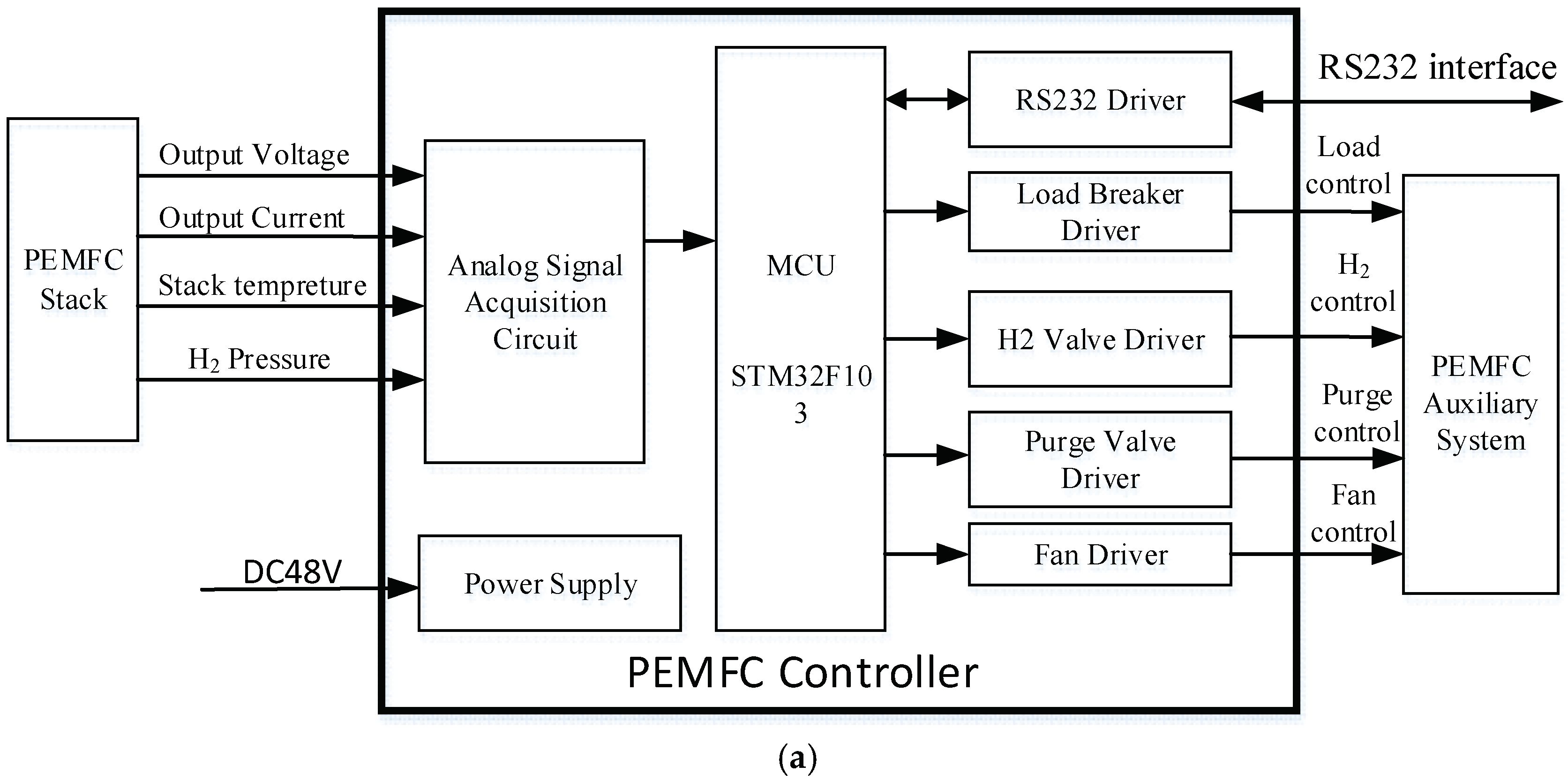
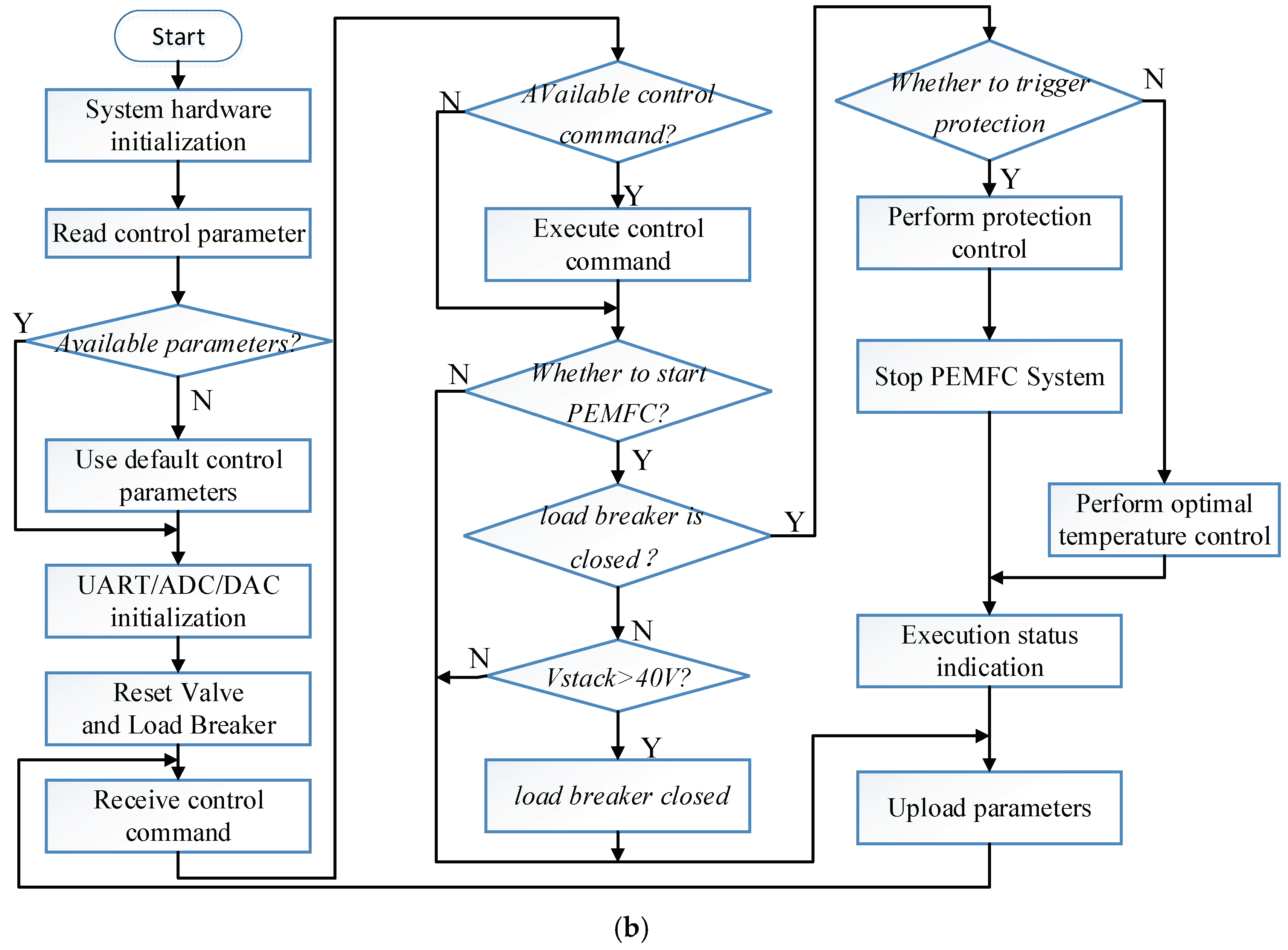
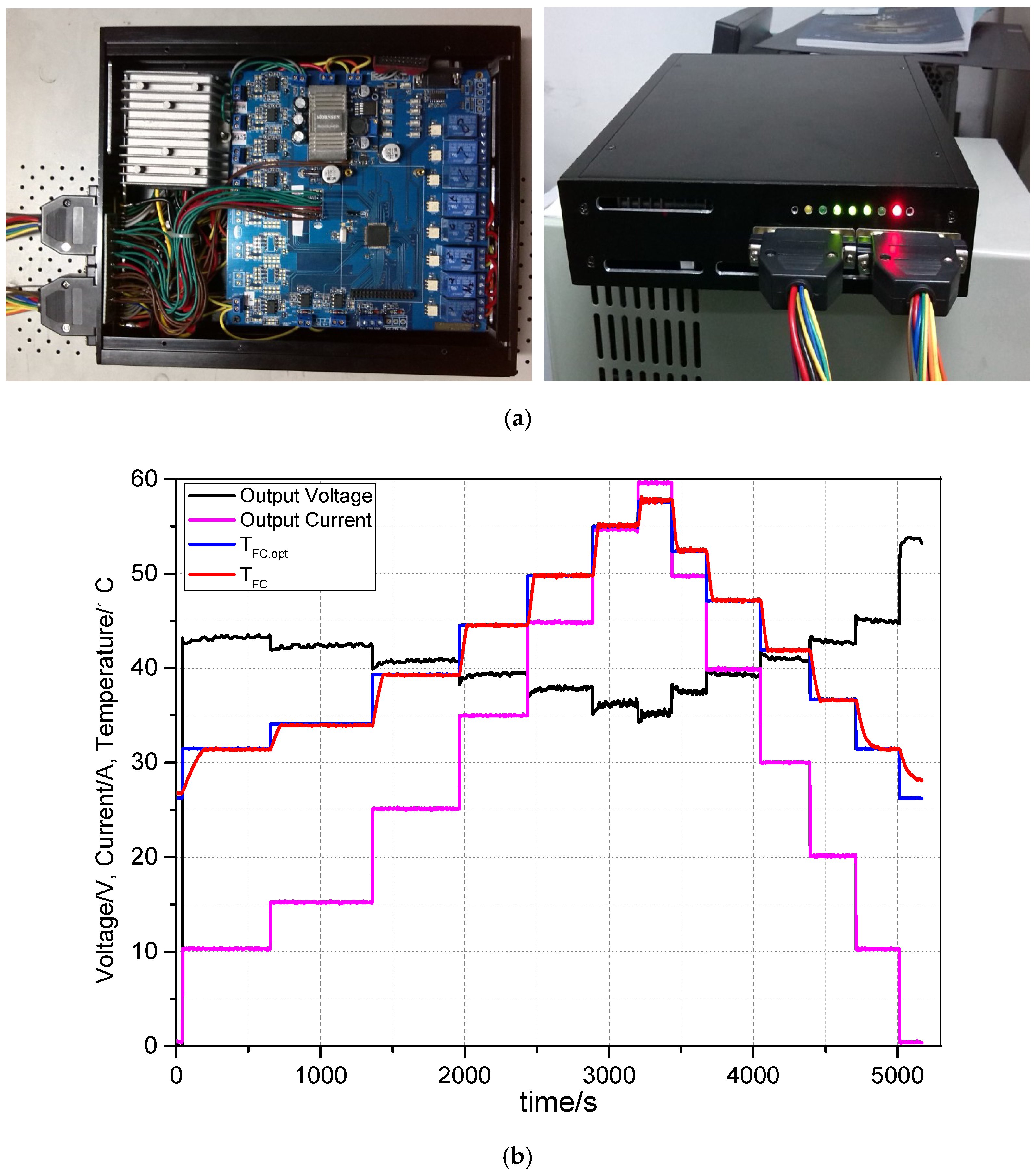
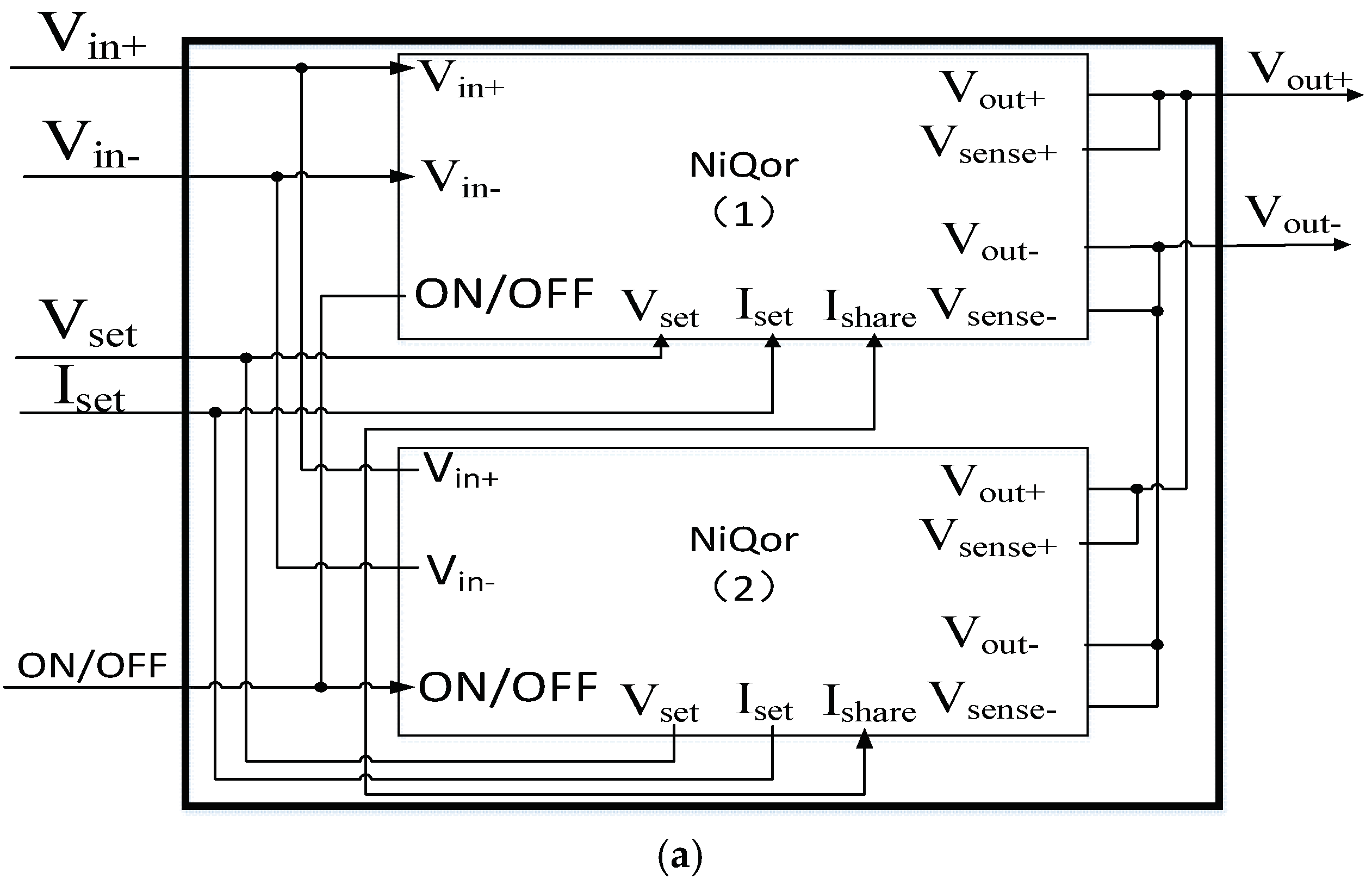
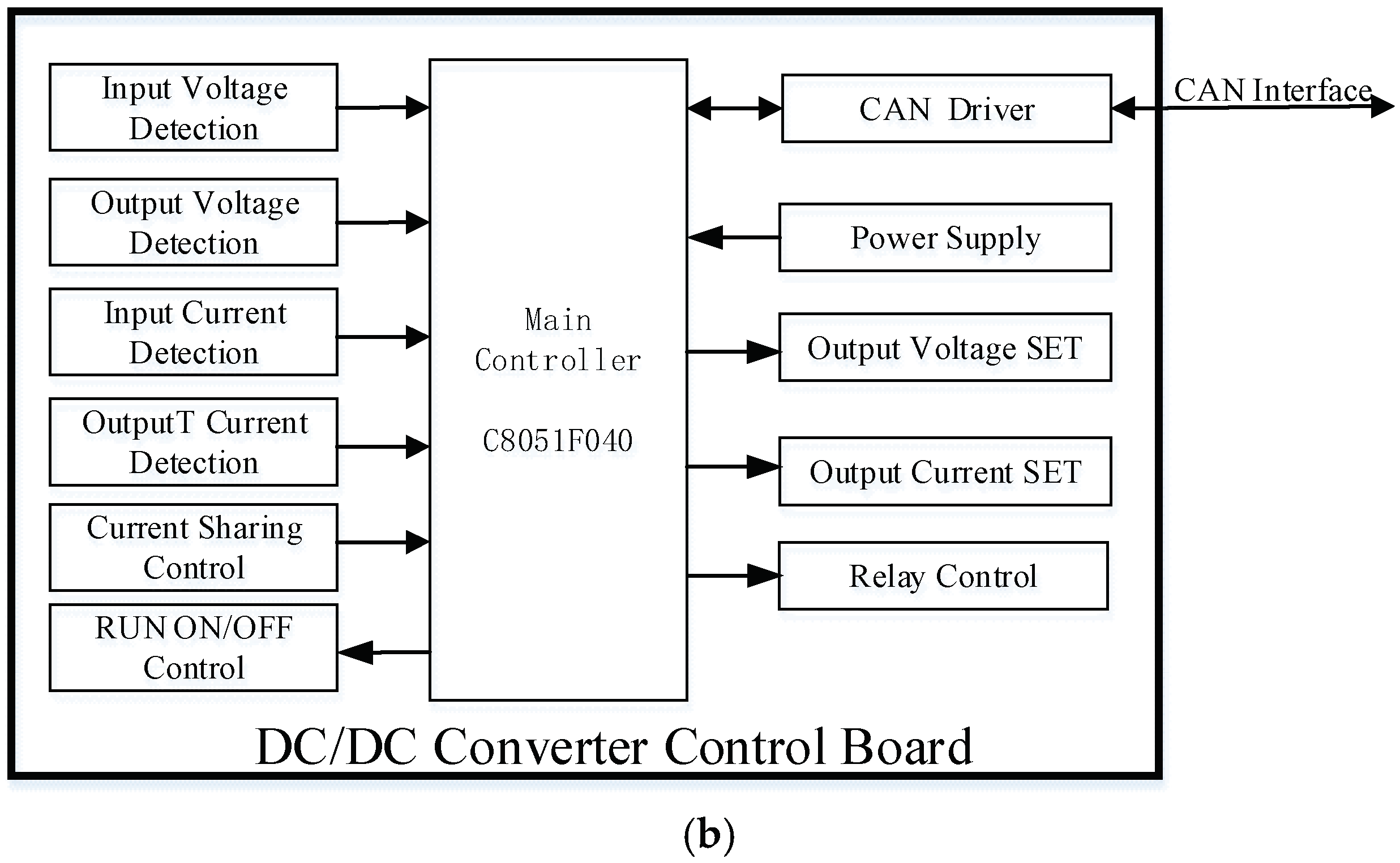

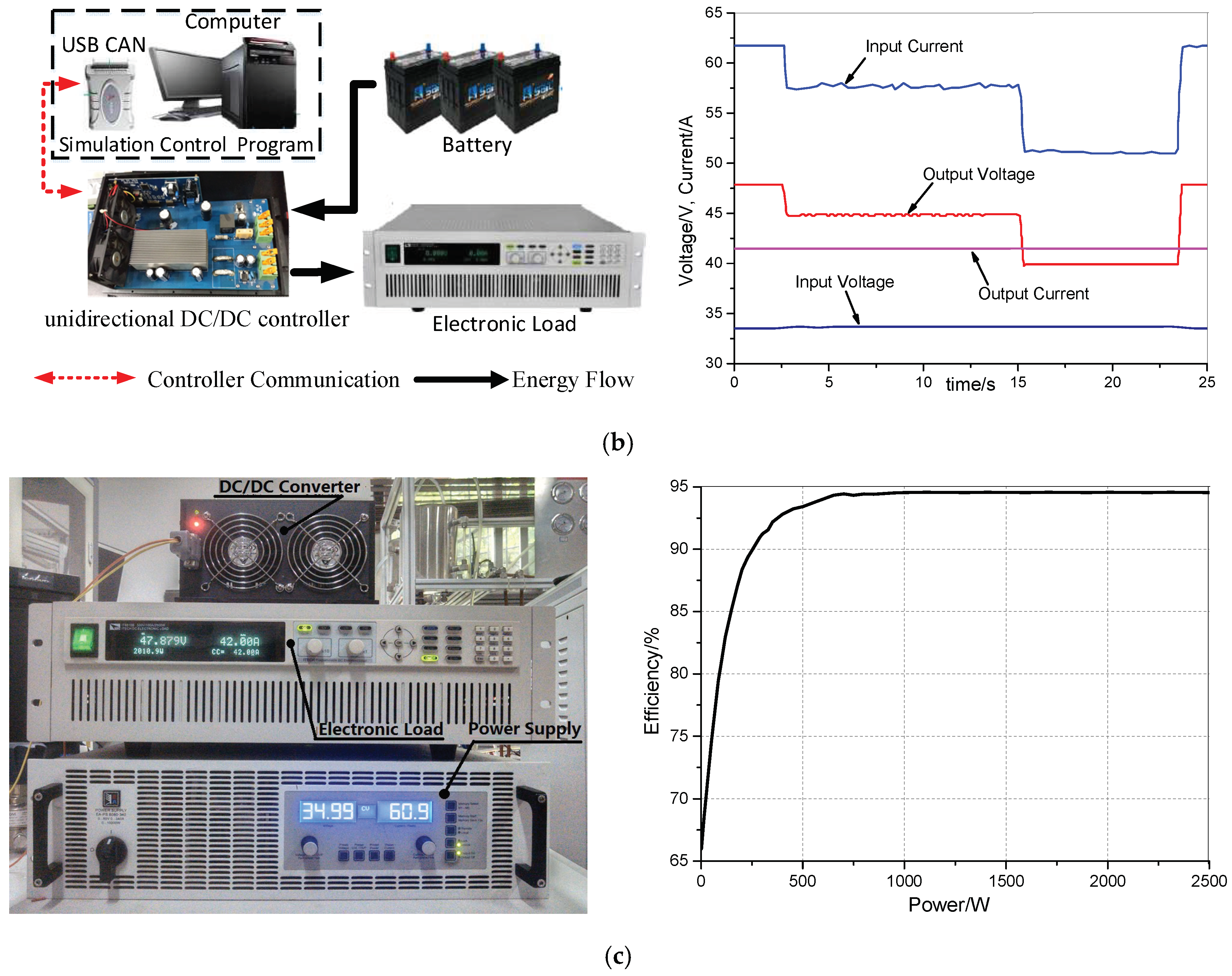
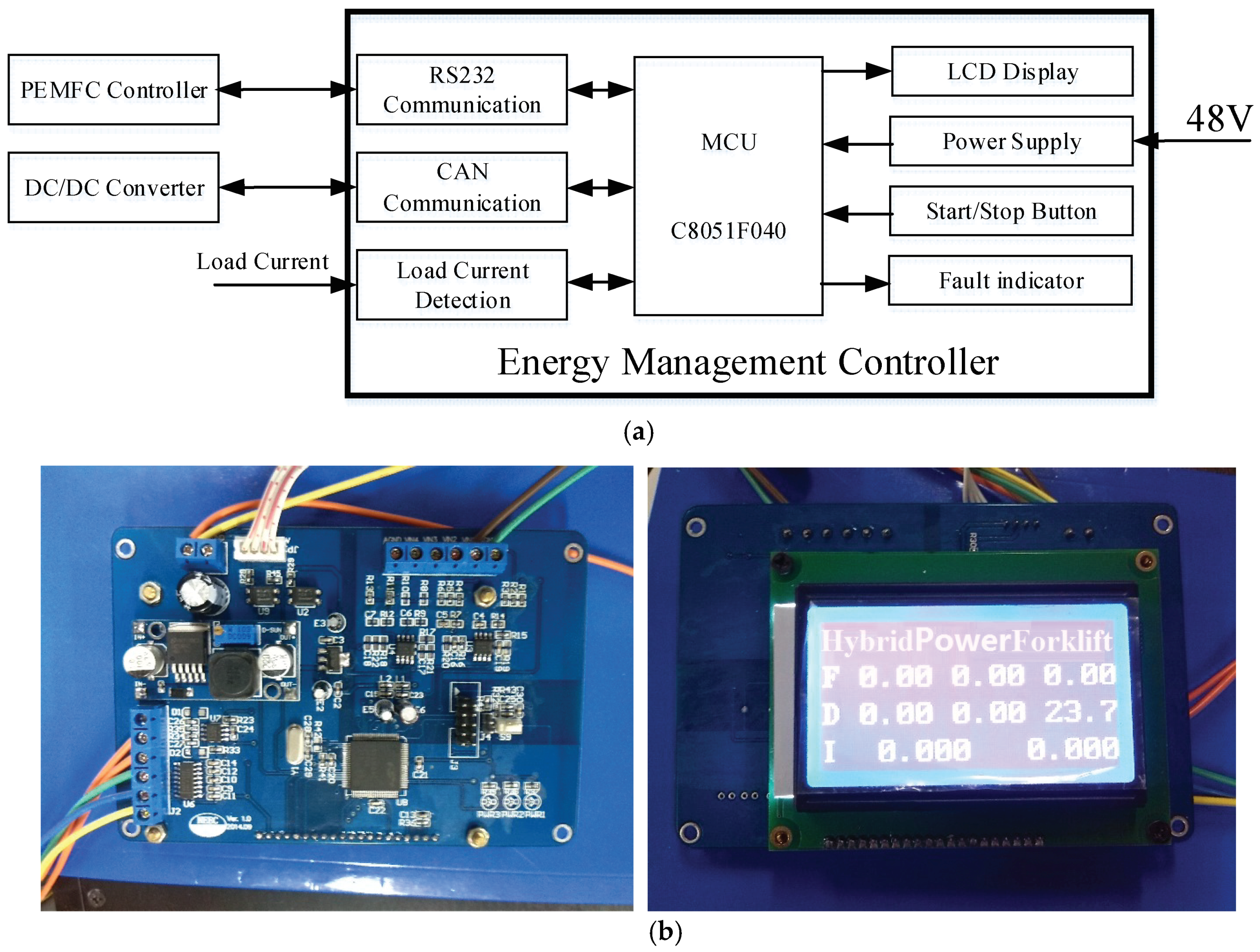
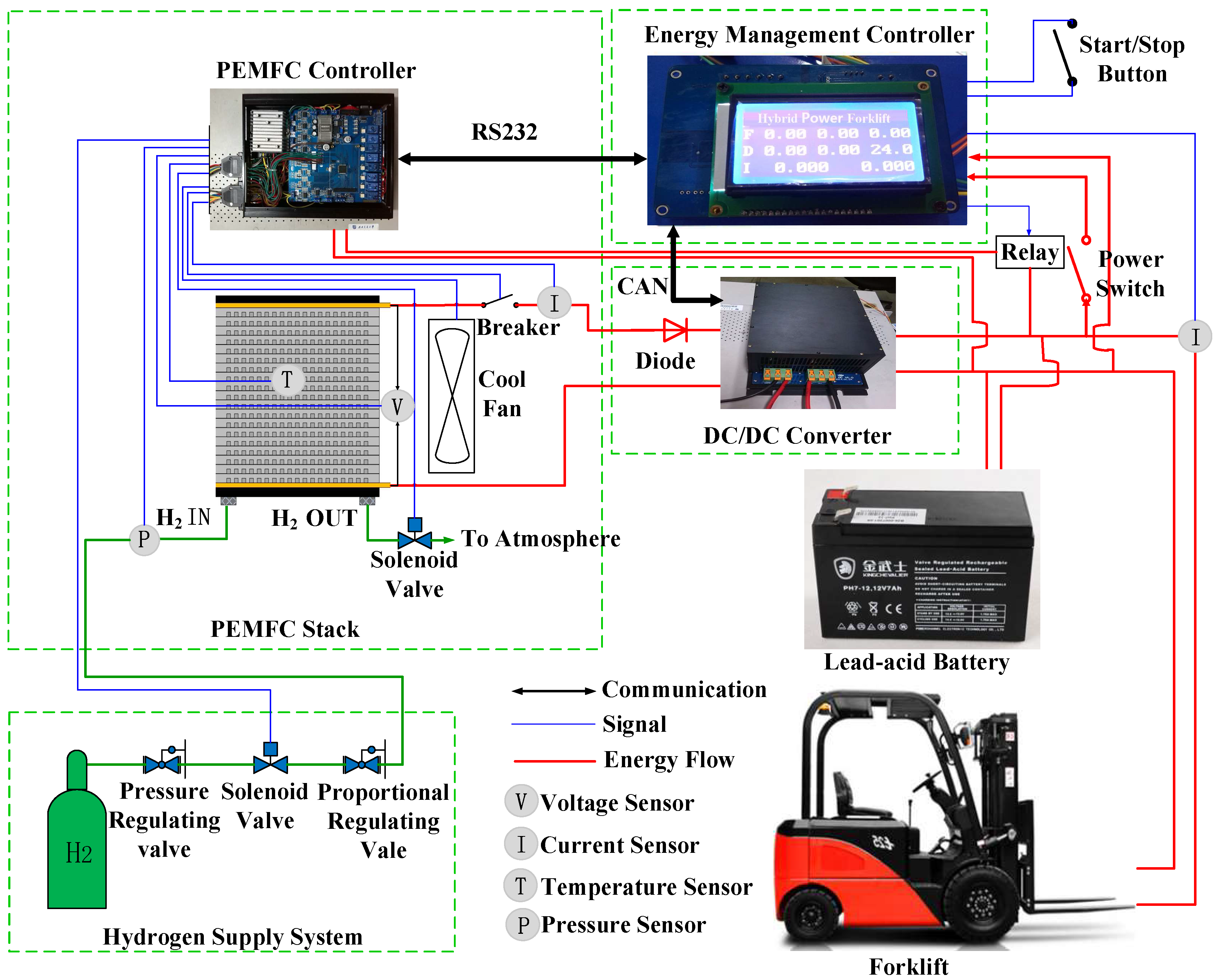
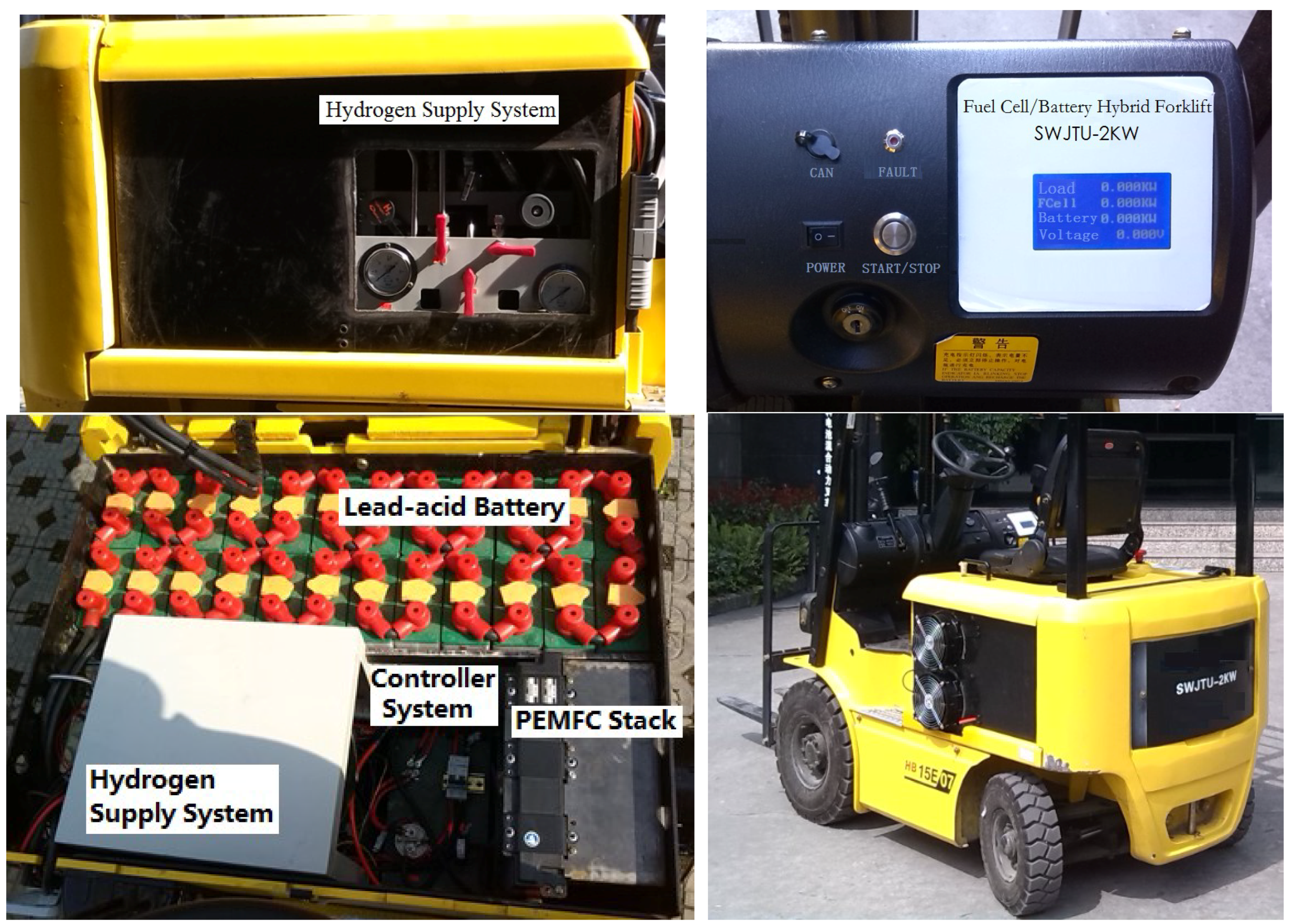
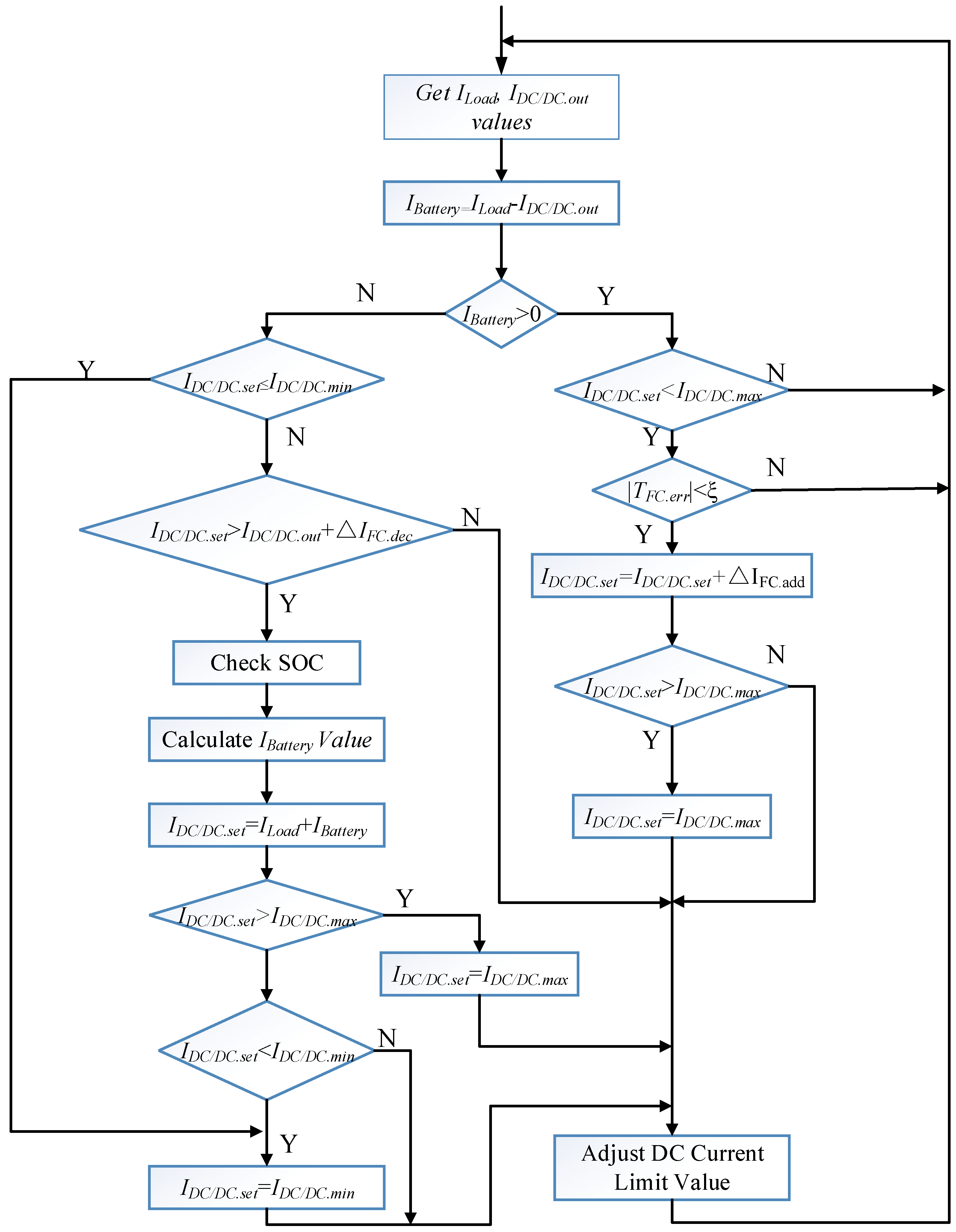
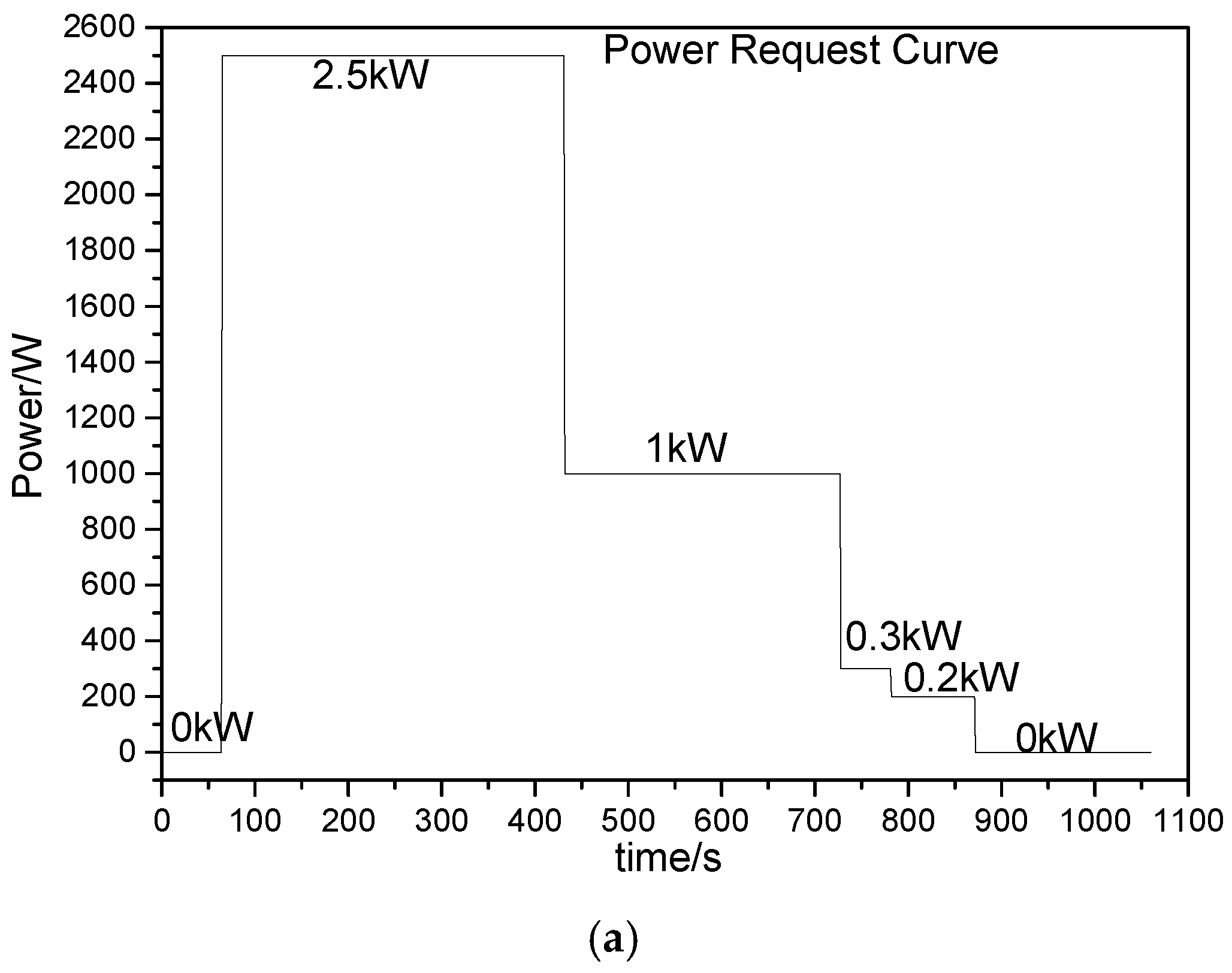
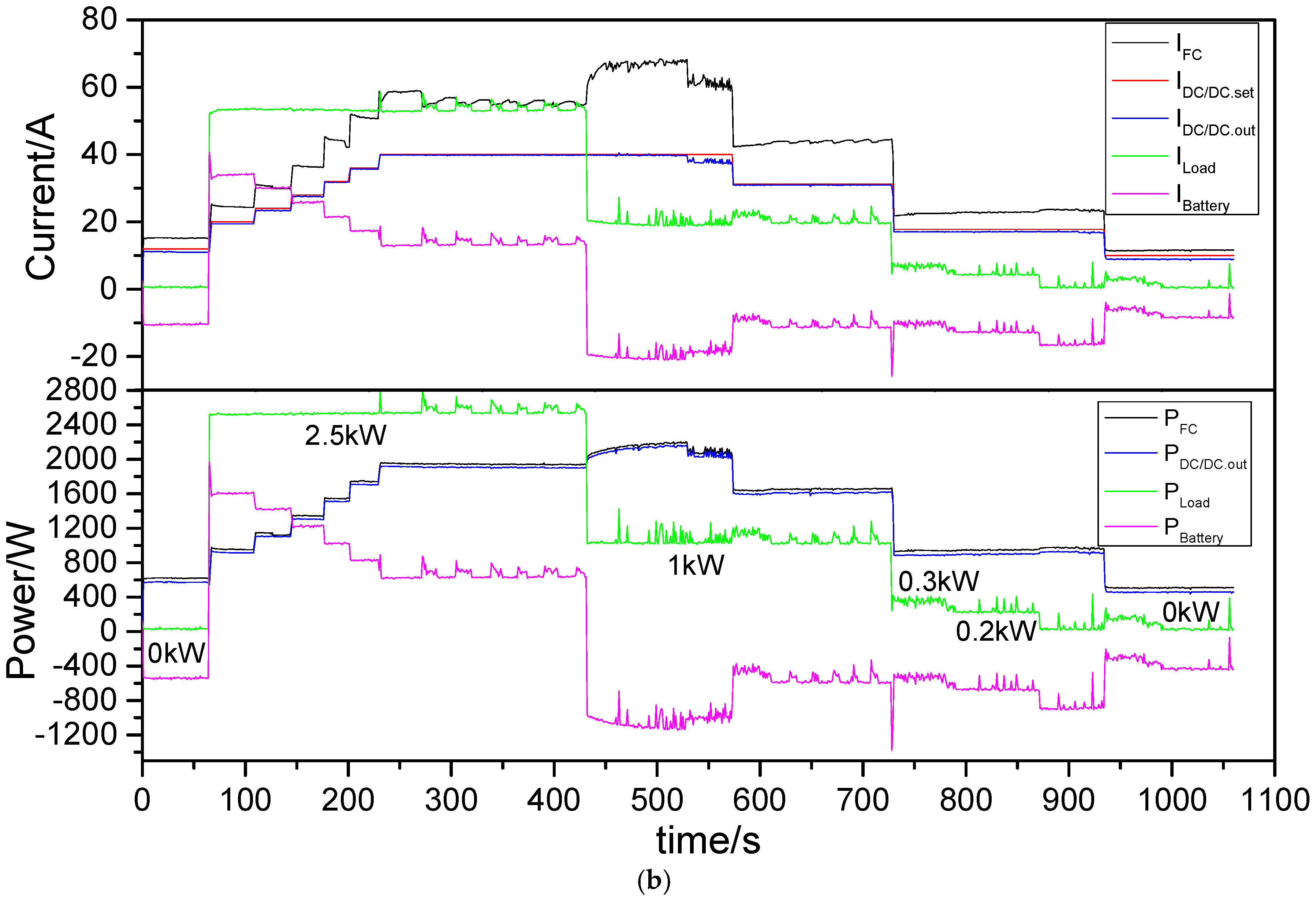
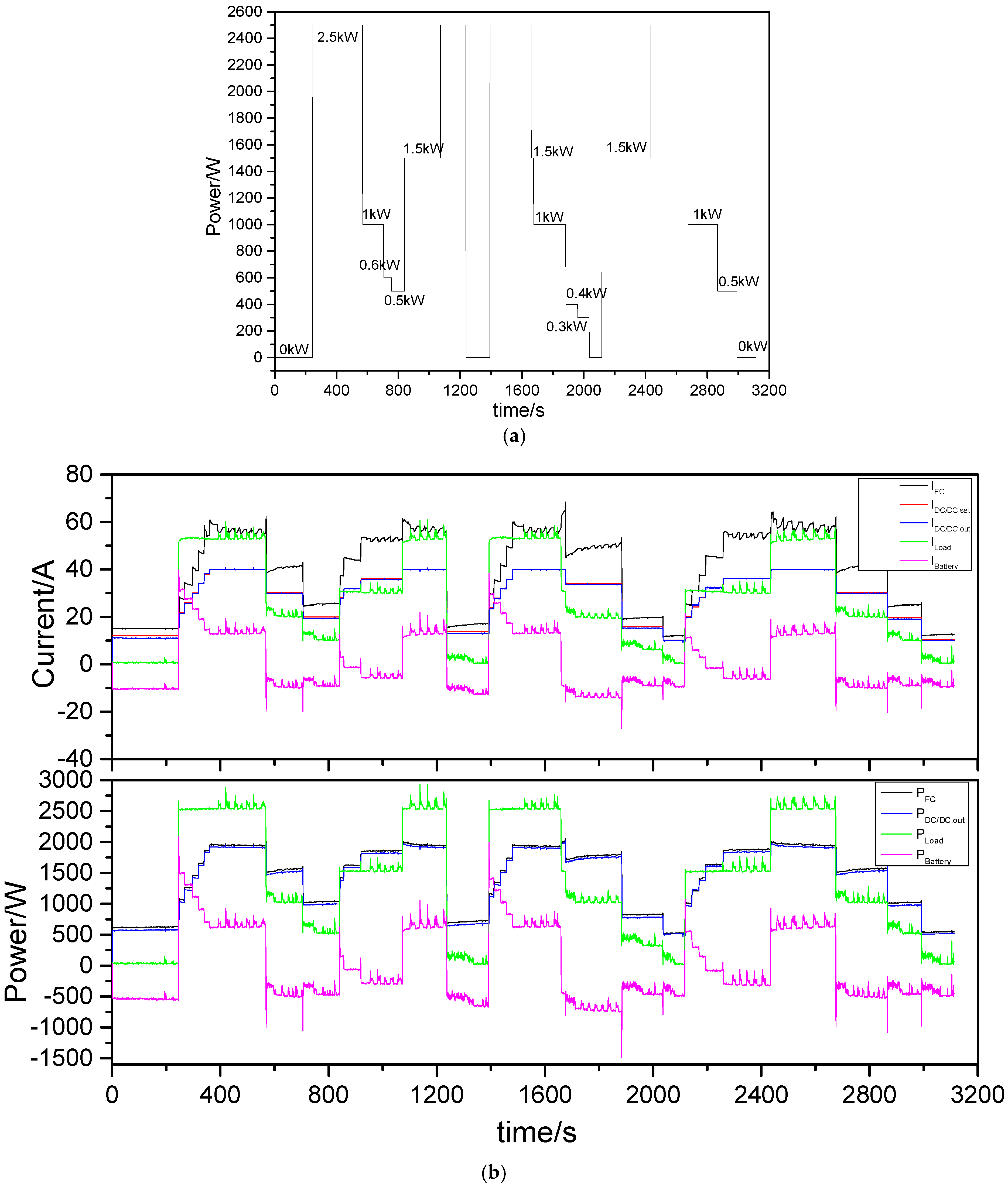
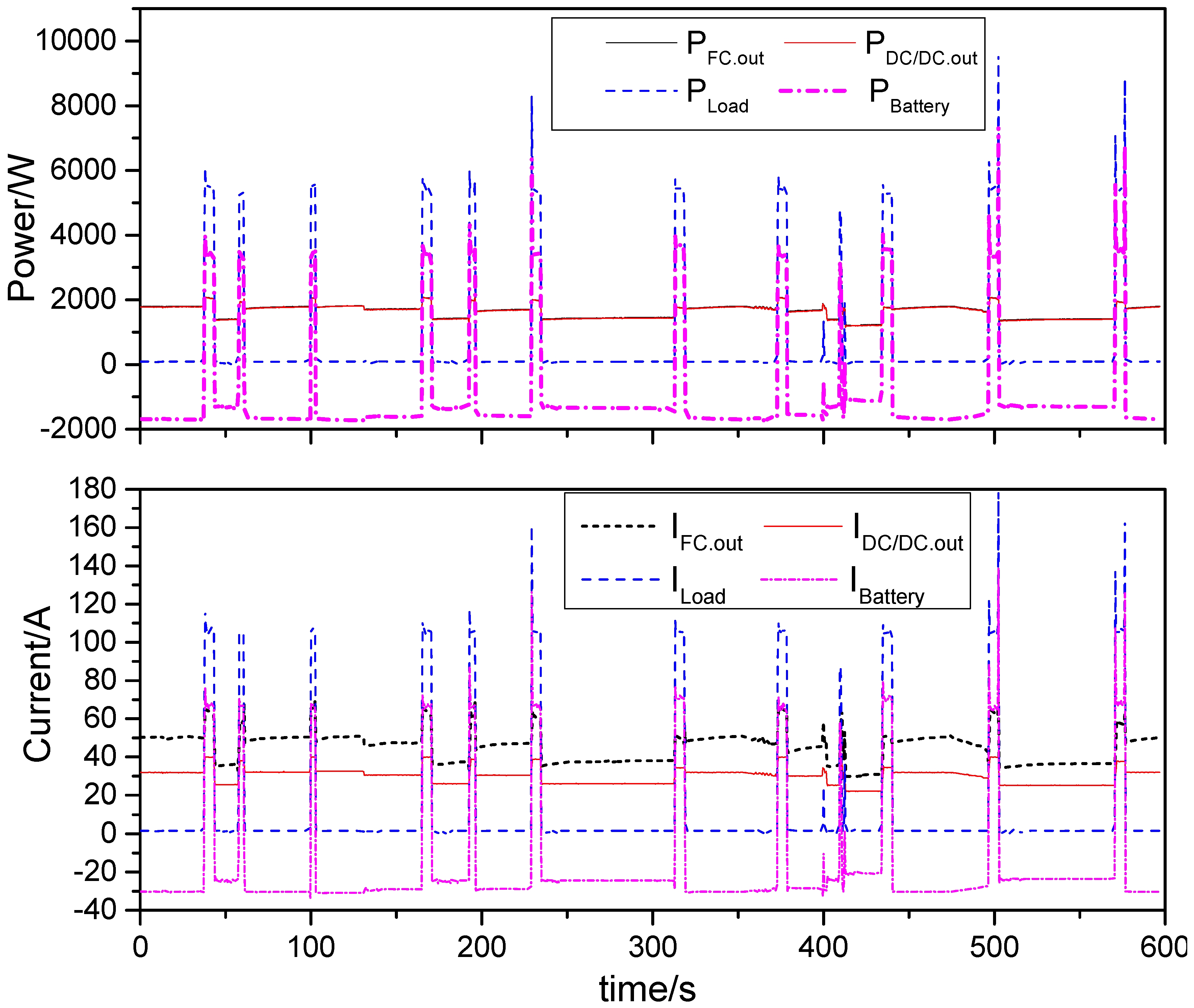
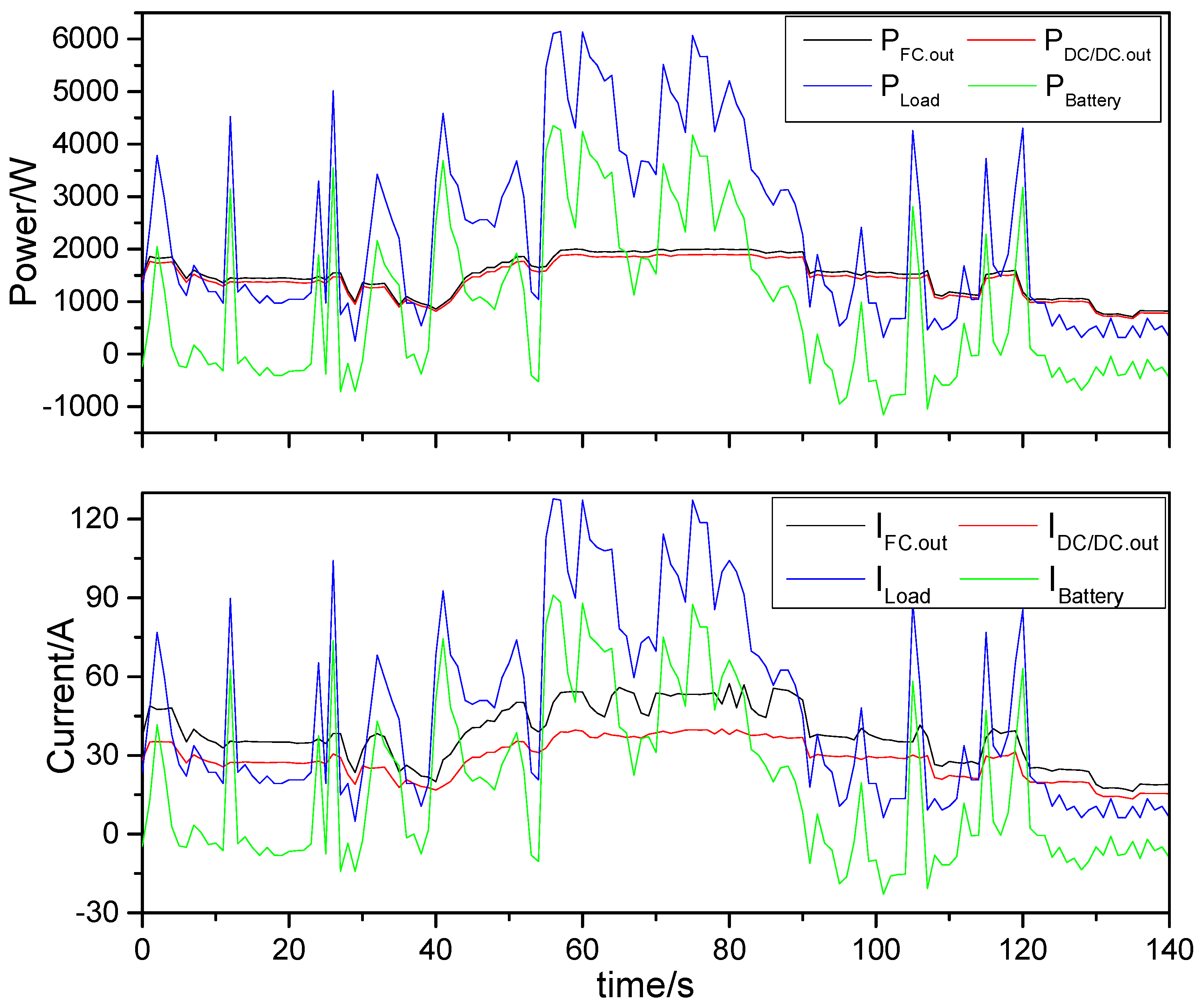
| SOC | SOC < 60% | 60% < SOC < 80% | 80% < SOC < 90% | SOC > 90% |
| Charging current | 0.3 C (30 A) | 0.2 C (20 A) | 0.07 C (7 A) | Floating charge |
| Subsystems | Descriptions | Values | |
|---|---|---|---|
| Fuel Cell (PEMFC) | Rated power | 2000 W | |
| Cells | 56 pieces | ||
| Voltage range | 30–56 V | ||
| Maximum current | 75 A | ||
| Maximum temperature | 75 °C | ||
| Lead-acid Battery | Rated voltage | 48 V | |
| Rated capacity | 100 Ah | ||
| Set numbers | 24 series | ||
| Forklift | Moving motor | Rated voltage | 48 V |
| Rated power | 6300 W | ||
| Lifting motor | Rated voltage | 48 V | |
| Rated power | 8600 W | ||
© 2018 by the authors. Licensee MDPI, Basel, Switzerland. This article is an open access article distributed under the terms and conditions of the Creative Commons Attribution (CC BY) license (http://creativecommons.org/licenses/by/4.0/).
Share and Cite
You, Z.; Wang, L.; Han, Y.; Zare, F. System Design and Energy Management for a Fuel Cell/Battery Hybrid Forklift. Energies 2018, 11, 3440. https://doi.org/10.3390/en11123440
You Z, Wang L, Han Y, Zare F. System Design and Energy Management for a Fuel Cell/Battery Hybrid Forklift. Energies. 2018; 11(12):3440. https://doi.org/10.3390/en11123440
Chicago/Turabian StyleYou, Zhiyu, Liwei Wang, Ying Han, and Firuz Zare. 2018. "System Design and Energy Management for a Fuel Cell/Battery Hybrid Forklift" Energies 11, no. 12: 3440. https://doi.org/10.3390/en11123440
APA StyleYou, Z., Wang, L., Han, Y., & Zare, F. (2018). System Design and Energy Management for a Fuel Cell/Battery Hybrid Forklift. Energies, 11(12), 3440. https://doi.org/10.3390/en11123440





